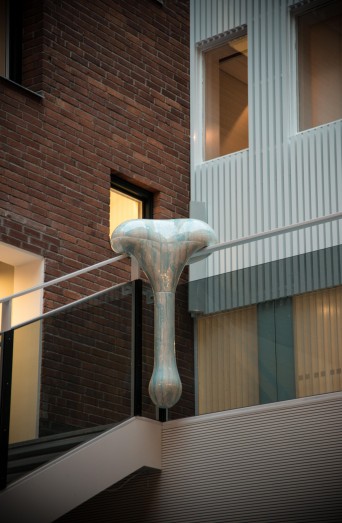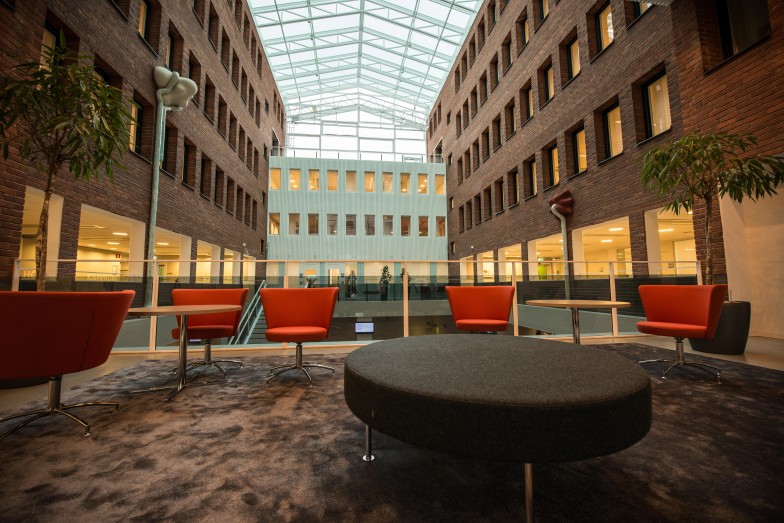









At the Swedish Tax Agency’s renovated head office in Solna, Annika Svensson’s ceramic work Flytande, rinnande, droppande … dripp, dropp (Flowing, running, dripping… drip, drop) provides a mysteriously humoristic dimension to a light well that was previously an anonymous space between two buildings. The architectural strictness of the 1970s façades needed to interact with its opposite: organic shapes in surprising contrast to the walls’ robust bricks. Annika Svensson refers to the effect of launching a container at the wall causing its contents to spill out. Resembling melted wax, a six-metre long thick string runs down the wall from a terracotta-coloured valve, an outdoor wall tap that looks as if has been retrieved from a cathedral. High up, a swollen, cloud-shaped white body has pipe-like growths similar to those in Svensson’s tiled ovens in modern Art Nouveau-hybrid style. A sack-like object has landed on a staircase and gravity is pulling it further downwards. However, these objects are not threatening aliens, they are only curious. Passing by on the stairs, one feels tempted to caress the lump and feel its ceramic skin replete with cracks and deep shifts.
Technically, the artist wanted to highlight Mochaware, a centuries-old decoration technique in which slipware, silted clay, is quickly painted with an acidic solution of coloured oxide that flows freely and furcates into an animated expression.
The presence of the three sculptures adds some healthy surrealism. It is as if the Swedish Tax Agency has burst its seams and begun to leak. What is oozing out? Light blue ideas, strips of clouds, a mirrored sky, an element of freedom in the heart of the government agency’s serious activity. Drops, slime and blobs are childishly fun. They are on their way, they are being transformed and the movement is the point. The objects that break out and seek their own ways become a portrait of people in the organisation and their whims and ideas, creativity and unexpected ways of developing.
The objects are the outcome of an experiment in a 1:50 spatial model. The light well has much sky with a beautiful descending daylight. A possible placement on the ground floor was abandoned in order to allow the work to be augmented, interconnecting the different environments on each floor. In the dining room furthest down one’s gaze searches out the formations of the work and follows them upwards. From the upper floors one sees a glimpse of what is oozing downwards, like a creek or a brook on the façade. Ceramic is a tactile and durable material.
The three ceramic sculptures were handmade in many different sections in Annika Svensson’s studio in Gothenburg. They have matt and gloss glazes and have been fired several times – a sensitive process – and then mounted in situ. Technically, the artist wanted to highlight Mochaware, a centuries-old decoration technique in which slipware, silted clay, is quickly painted with an acidic solution of coloured oxide that flows freely and furcates into an animated expression. Previously, the technique was used for dinner services. The watery surfaces give life to the dry material and symmetry of the facades, an interplay of movements, light and material balances.
Petter Eklund

Find the artwork
Solna, Vinter 2015
Korta gatan 10, 171 54 solna